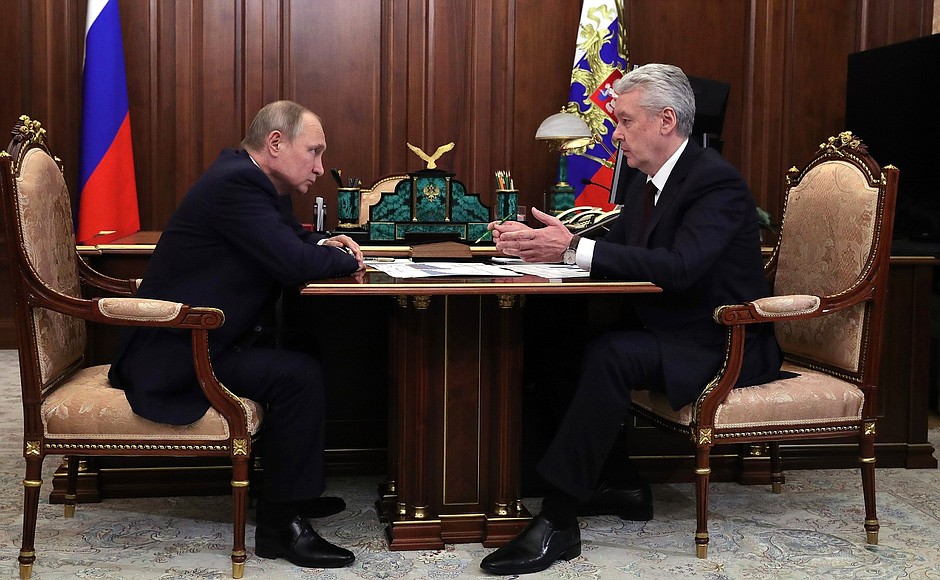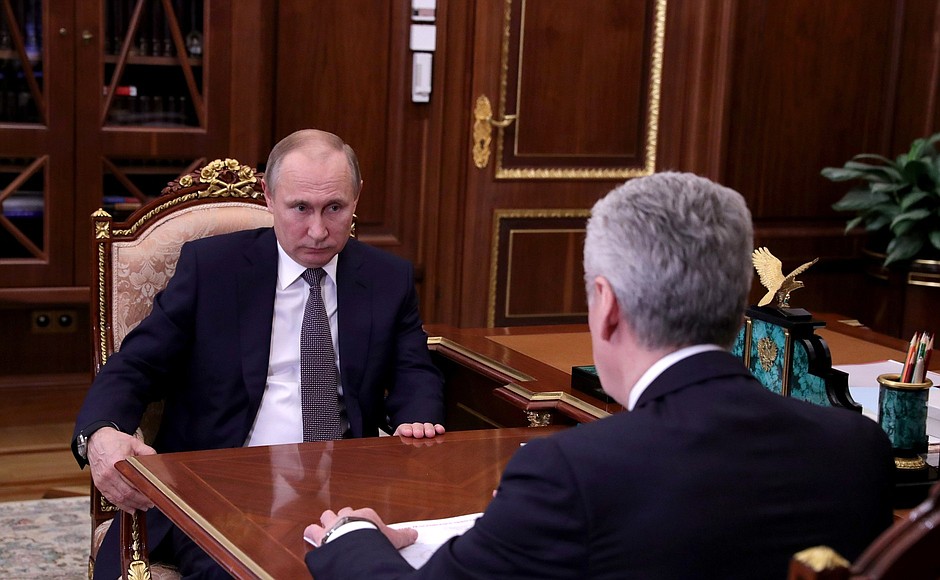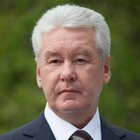President of Russia Vladimir Putin: Mr Sobyanin, there is no need to state Moscow’s role and importance for the country, so instead of making lyrical pronouncements, I propose that we discuss the development of this metropolitan area and the challenges it faces in the process.
Speaking about positive developments I can highlight the city’s financial standing. It is clear that it is attributable not only to the fact that so many people are registered in the capital, but also to the way the city is managed. The size of the available funds is not as important as the way they are used.
Overall, your team has been highly professional in its activities. Moscow has very high indicators in terms of population prosperity and boasts the lowest unemployment rate in the country, which is also noteworthy. Fixed capital investment is above the national average. These are all positive developments.
That said, there are also recurring challenges that you know all too well, including traffic congestion and the need to better regulate migration flows. There are also other issues that we have discussed on numerous occasions.
You have also undertaken a number of major projects, including the development of the transport system. The effort to expand the metro is underway and a new station has opened recently. There is the central circle line, a new rail line with new trains that we launched together, helping ease congestion in the city. There are also many other projects underway.
Let us discuss all this.
Moscow Mayor Sergei Sobyanin: Mr President, as we have discussed earlier, Moscow is gradually recovering from the economic crisis and steadily developing its economy. In the past year, all indicators without exception showed positive momentum, including investment, trade, wages and industrial output.
As you said, we invest substantial resources in infrastructure development in order to resolve one of the major challenges the city is facing, which is to enhance its connectivity and develop transport communications. You attended the launch ceremony of the Moscow Central Circle, which operates as an above-ground metro line. We have now launched the construction of a major underground circle line. Its first segment, from the Moscow International Business Centre to Dinamo, was launched in 2018, and from now on new segments are expected to be put into operation every year. Almost all sections of this circular line are now under construction, be it drilling by tunnelling machines, construction of metro stations or design work. That is to say that we are working on all sections of the new line, which will enable us to complete it within four or five years at the most. As a result, we will have two new circular lines that will serve as the foundation of the city’s core transport infrastructure.
As the city invests in the development of roads, commuter rail and metro, we are receiving feedback from investors. If you look at this chart, the numbers highlighted in red represent government investment in transport and social infrastructure: schools, hospitals and housing. At the same time, we are getting a lot of private investment. Since 2010, fixed capital investment increased by 176 percent in comparable prices, or from 700 billion to 2 trillion. This investment is channelled into various sectors, including manufacturing, research, innovation, automobile construction, etc. The funds are distributed evenly among various sectors without any of them getting a significant edge over the other in terms of investment.
This is supported by the recent growth data. In the main sectors of the city’s economy, growth rates range from 113 and 162 percent. This applies to the processing industries, the production of trade and office furniture, various other segments, and rail transport.
Along with stepping up manufacturing, we can say that indeed we are filling the niche that was freed from imports, but apart from saturating the domestic market this sector has begun to actively work for exports. The export trend – non-resource exports, mostly the processing industries, science and information technologies – has gone up by 31 percent. This is generally an impressive trend.
This has been contributed to, as you rightly said, the progress of small and medium-sized businesses that we spoke about at the last State Council meeting. It brings both extra revenues to the budget and boosts the innovative economy.
As you remember, in 2013 you set significant tasks in developing and supporting small and medium-size business. Look at the dynamics of public tenders with the participation of small and medium-size businesses. We set out with four percent. Small and medium-size businesses had a four percent share in the state procurement orders, and it hardly changed through 2013. Then there was a leap, and you see the figures we have reached: practically a third of the state procurement order goes to small and medium-sized businesses. They definitely create a new economy, export flows and so on, and it is a considerable addition to the budget.
It is not only the share of small and medium-sized businesses in the state procurement order that is growing – but also the number of companies has gone up by 22 percent in three years. And we can see that this is not just a “dead,” formal number. The volume of lending testifies to the fact that this business is on the upswing, it is attracting investments for its development and, correspondingly, contributes to the city’s growth. In 2017 alone, it contributed 26 percent of budget revenues. You keep saying that small business growth should accompany the region’s economic development. Here is a vivid example of what creates extra growth. The figures are very substantial for Moscow.
Tourism has also begun to actively develop alongside with small and medium-sized businesses. Despite all the sanctions, restrictions and overall a tough and at times biased attitude towards our country, we nevertheless see that even foreign tourism grew by 40 percent in the past years whereas domestic tourism went up by 80 percent. In 2010, we welcomed 12.8 million tourists in the city while last year there were 21 million of them.
The economy has grown respectively: receivables grew from 200 to 700 billion rubles. This is a huge sector of the economy: hotels, services, retail, and so on and so forth, and a good contribution to the budget. That is, the funds we once allocated to the city’s infrastructure, improvement, parks and streets, now keep returning directly to the budget owing to the turnover, increased number of tourists, their purchasing power and so on.
Mr President, small and medium-sized business gave a large boost also to the growth of the innovative economy. During that period, 33 techno parks were set up in the city where thousands of small and medium-sized enterprises operate. Thirty-nine industrial complexes have been registered which also have innovative development as their basis.
We started looking into where innovative business is located in Moscow and which enterprises represent it. It is generally believed that we only have one large techno park, several small techno parks, and some institutes, thus it is not easy to see the complete innovative picture of Moscow. When we summed up all that information beginning with techno parks, high-tech IT companies, business incubators, institutes and academic institutions, it transpired the all of Moscow, the whole map of Moscow is dotted with innovative infrastructure facilities.
Vladimir Putin: Does it include children’s techno parks?
Sergei Sobyanin: Yes, it does. But there is a problem: as of today, they operate separately. There is federal property, there is regional property, private property, there are academic institutions, industrial, manufacturing and sectoral institutes and so on. Many of them have never even heard of each other.
There emerged an idea (we discussed it with the Ministry of Industry) to set up a research industrial cluster in Moscow. This would be done in such a way that it would become a single integrator of all that infrastructure, help them find each other, create a unified information system for us to understand what help they need, what kind of support in order to create a synergy of this tremendous potential. It is one of the biggest clusters in the world in terms of its power, potential, the number of projects and designs, and the number of researchers involved.
This is why we would like to ask you to draft an executive order to set up such a research industrial cluster so as to unite all those separate entities to create synergy for the development of Moscow’s research and industrial potential.
Vladimir Putin: It should be thoroughly thought out so that the implementation of the suggested idea – which is definitely very interesting – would not interfere with anybody in any way, would not tie hands but rather help all the participants in this wonderful process.
Sergei Sobyanin: This is the key plan – to help them develop and make them recognisable, to set up a venue where they could present themselves to attract investments and cooperate with each other.
<…>



